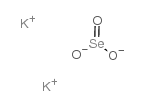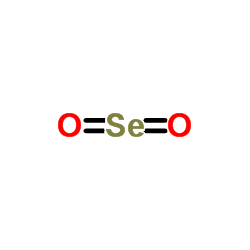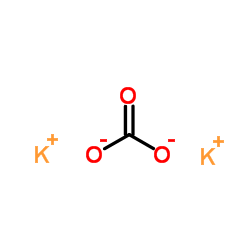亚硒酸钾 ,Potassium selenite ,Se ≥38%
产品编号:Bellancom-B432360| CAS NO:10431-47-7| 分子式:K2O3Se| 分子量:205.1548
本网站销售的所有产品仅用于工业应用或者科学研究等非医疗目的,不可用于人类或动物的临床诊断或者治疗,非药用,非食用,
| 产品名称 | 亚硒酸钾 |
|---|---|
| 英文名称 | Potassium selenite |
| CAS编号 | 10431-47-7 |
| 产品熔点 | 875ºC |
| 精确质量 | 205.82900 |
| PSA | 63.19000 |
| 稳定性 | 遵照规格使用和储存则不会分解。 极易潮解,易溶于水。 |
| 储存条件 | 密封于阴凉干燥处。 |
相关文档
化学品安全说明书(MSDS)
下载MSDS质检证书(COA)
相关产品
| 危害码 (欧洲) | T: Toxic; |
|---|---|
| 风险声明 (欧洲) | 23/25-33-50/53-36/37/38-23/24/25 |
| 安全声明 (欧洲) | S22;S26;S28;S45;S36/S37/S39 |
| 危险品运输编码 | UN 2630 |
| RTECS号 | VS7200000 |
| 包装等级 | I |
| 危险类别 | 6.1 |
|
Section 1: Product Identification Chemical Name:Potassium selenite CAS Registry Number:10431-47-7 Formula:K2SeO3 EINECS Number:233-909-8 Chemical Family:inorganic compound Synonym:Dipotassium selenite
Section 2: Composition and Information on Ingredients IngredientCAS NumberPercentACGIH (TWA)OSHA (PEL) Title compound10431-47-7100%0.2mg/m3 (as Se)0.2mg/m3 (as Se) Section 3: Hazards Identification Poison. Ingestion may be fatal at low doses. Inhalation may cause shortness of breath, garlic odor, chills and Emergency Overview: headache. Chronic exposure may result in nervous disorders, liver and kidney disease. Primary Routes of Exposure:Ingestion, inhalation, skin, eyes. Eye Contact:May cause severe irritation, redness, pain. Skin Contact:May causes severe irritation. Symptoms include redness, itching and pain. Inhalation can cause garlic odor and shortness of breath, chills, headache, and delayed pulmonary edema. Inhalation: Toxic by inhalation. Ingestion:Toxic. May be fatal if swallowed. May cause gastrointestinal irritation, nausea and vomiting. May be irritating to skin, eyes and respiratory tract, and cause nausea, vomiting, bloody diarrhea, weakness, Acute Health Affects: chills, headache, and delayed pulmonary edema. Prolonged exposure to selenium compounds may cause dermatitis, diarrhea, liver damage, nervous disorders, Chronic Health Affects: lameness and loss of vitality. NTP:No IARC:No OSHA:No SECTION 4: First Aid Measures Immediately flush the eyes with copious amounts of water for at least 10-15 minutes. A victim may need Eye Exposure: assistance in keeping their eye lids open. Get immediate medical attention. Wash the affected area immediately with water. Remove contaminated clothing if necessary. Seek medical Skin Exposure: assistance if irritation persists. Remove the victim to fresh air. Closely monitor the victim for signs of respiratory problems, such as difficulty Inhalation: in breathing, coughing, wheezing, or pain. In such cases seek immediate medical assistance. Seek medical attention immediately. Keep the victim calm. Give the victim water (only if conscious). Induce Ingestion: vomiting only if directed by medical personnel. SECTION 5: Fire Fighting Measures Flash Point:no data Autoignition Temperature:no data Explosion Limits:no data Extinguishing Medium:carbon dioxide or dry powder If this product is involved in a fire, fire fighters should be equipped with a NIOSH approved positive pressure Special Fire Fighting Procedures: self- contained breathing apparatus and full protective clothing. Hazardous Combustion andIf involved in a fire, toxic oxidation or decomposition products may form. Decomposion Products: Unusual Fire or Explosion Hazards: Non-flammable. No unusual fire or explosion hazard. SECTION 6: Accidental Release Measures Spill and Leak Procedures:Sweep up the solid and dispose of properly. SECTION 7: Handling and Storage Handling and Storage:Store in a cool, dry place in a tightly sealed container. SECTION 8: Exposure Controls and Personal Protection Eye Protection:Always wear approved safety glasses when handling a chemical substance in the laboratory. Skin Protection:Wear protective clothing and gloves. Consult with glove manufacturer to determine the proper type of glove. Ventilation:Handle the material in an efficient fume hood. If ventilation is not available a respirator should be worn. The use of respirators requires a Respiratory Respirator: Protection Program to be in compliance with 29 CFR 1910.134. Ventilation:Handle the material in an efficient fume hood. Additional Protection:No additional protection required. SECTION 9: Physical and Chemical Properties Color and Form:white powder Molecular Weight:205.16 Melting Point:875° dec. Boiling Point:no data Vapor Pressure:no data Specific Gravity:no data Odor:none Solubility in Water:soluble SECTION 10: Stability and Reactivity Stability:hygroscopic Hazardous Polymerization:no hazardous polymerization Conditions to Avoid:none Incompatibility:active metals and oxidizing agents Decomposition Products:potassium oxide and selenium oxide SECTION 11: Toxicological Information RTECS Data:Status: EPA Genetox Program 1988: negative B subtilis rec. assay. Carcinogenic Effects:no data Mutagenic Effects:Negative data Tetratogenic Effects:no data SECTION 12: Ecological Information Ecological Information:No information available SECTION 13: Disposal Considerations Disposal:Dispose of according to local, state and federal regulations. SECTION 14: Transportation Shipping Name (CFR):Selenates or Selenites Hazard Class (CFR):6.1 Additional Hazard Class (CFR):NA Packaging Group (CFR):I UN ID Number (CFR):UN# 2630 Shipping Name (IATA):Selenates or Selenites Hazard Class (IATA):6.1 Additional Hazard Class (IATA):NA Packaging Group (IATA):I UN ID Number (IATA):UN# 2630 SECTION 15: Regulatory Information TSCA:Listed in the TSCA inventory SARA (Title 313):See Category Code N725 for reporting. Second Ingredient:none SECTION 16 - ADDITIONAL INFORMATION N/A |










 浙公网安备 33010802013016号
浙公网安备 33010802013016号